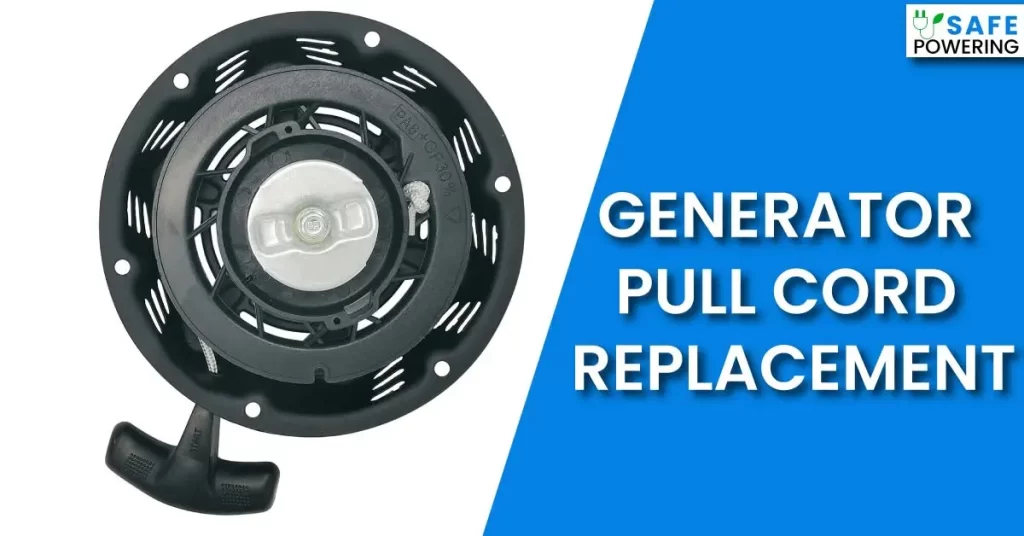The Ultimate 4-STEP Guide to Generator Pull Cord Replacement
Is your generator’s pull cord broken? Our DIY guide to generator pull cord replacement will help you replace it safely and save on repair costs.
If you own a generator, you know how important it is to keep it running smoothly, especially during power outages that are becoming more frequent and prolonged by the day.
Unfortunately, even the best generators can run into problems over time, and one of the most common issues is a broken pull cord.
A generator pull cord might malfunction due to a frayed cord, a seized piston, a damaged engine, or a hydro-locked engine.
When this happens, you might think it’s time to replace the entire generator, but the good news is that a generator pull cord replacement is a relatively easy fix that you can do yourself.
In this article, we’ll provide you with all the information you need to know about replacing a generator pull cord.
How Does a Generator Pull Cord Work?

A generator starter rope is a component that allows the engine to start by engaging a recoil mechanism when pulled.
The rope winds around a pulley connected to the flywheel, which transfers the rotational energy to the engine’s pistons, ultimately powering the generator.
It’s crucial to keep the starter rope clean and lubricated to ensure smooth operation.
When the rope breaks or becomes damaged, prompt replacement is necessary to prevent further damage to the engine or other components.
Replacing a generator starter rope is a relatively straightforward process that can be done at home with the right tools and technical knowledge.
How To Fix Generator Rope Within 4 Steps?
Changing the generator rope, also known as the starter rope, can be a simple DIY task that can be completed with a few basic tools. Here are the steps you can follow to change a generator rope:
Materials and Tools Needed:
Step 1: Remove the Old Rope:
Remove the Old Rope Locate the starter assembly cover on your generator.
This is typically on the side of the engine and held in place by a few screws. Use the screwdriver to remove the screws and take off the cover.
Once the cover is off, you should be able to see the old rope attached to the starter assembly. Use pliers to remove the old rope by pulling it out of the assembly and discarding it.
Step 2: Prepare the New Pull Cord:
Prepare the New Rope Measure the length of the old rope and use it as a guide to cut a new rope to the same length.
Tie a knot at one end of the new rope, making sure that the knot is large enough to prevent the rope from slipping through the starter assembly.
It happens to me a lot. I tend to have this habit of forgetting to tie a knot at one end. Make sure to remember.
Step 3: Install the New Rope:
Locate the hole in the starter assembly where the old rope was previously attached. Feed the new rope through this hole and any other guide holes that it needs to pass through.
As you are feeding the rope through, be sure to keep tension on it so that it doesn’t get tangled or twisted.
Once the rope is through all the necessary guide holes, tie a knot on the other end of the rope.
This knot will prevent the rope from slipping back through the starter assembly. Make sure the knot is large enough so that it cannot pass through the hole in the starter assembly.
Step 4: Reassemble the Cover:
With the new rope properly installed, you can now reassemble the starter assembly cover.
Place the cover back in position over the starter assembly and use a screwdriver to tighten the screws, ensuring that the cover is secure.
Give the new rope a few pulls to make sure that it is securely in place and that the starter assembly engages properly when the rope is pulled.
If everything is working as it should, you’re done! Your generator rope has been successfully changed and is ready to use.
It is important to note that changing a generator rope can be a relatively simple task, but it is also important to take safety precautions while doing so.
If you encounter any issues during the process, it is recommended to consult the manufacturer’s instructions or seek assistance from a qualified technician.
Recommended Read: How to change/clean generator’s air filter?
Why Generator Pull Cord Not Working?
One possible reason for a generator rope not working is that the rope itself is damaged or worn out.
Over time, the rope can become frayed, which makes it difficult to pull and can cause it to break. If the rope is damaged, it will need to be replaced with a new one.
Another possible reason for a generator rope not working is that the engine is flooded. When an engine is flooded, it means that there is too much fuel in the combustion chamber, which can prevent the engine from starting.
This can happen if the generator is left unused for an extended period, or if the carburetor is not adjusted correctly.
Here are some other possible reasons:
1. Damage Flywheel:
The flywheel is a key component of a generator’s engine. It is responsible for storing energy and helping to keep the engine running smoothly.
If the flywheel is damaged, it can cause the generator rope to stop working. This can happen if the flywheel becomes bent or cracked, or if it becomes unbalanced.
A damaged flywheel can cause the generator to vibrate excessively, which can make it difficult to start the engine. In some cases, a damaged flywheel may need to be replaced to fix the issue.
After you remove the recoil starter assembly, the flywheel will be visible. It will be connected to the crankshaft.
2. Hydro-Locked Engine:
A hydro-locked engine is a serious problem that can occur when water or any other liquid enters the engine’s combustion chamber.
It is the case when liquid sits on top of the piston preventing combustion to happen.
This can happen if the generator is exposed to water, such as during a flood or heavy rainstorm.
When water enters the combustion chamber, it can prevent the engine from turning over, which can cause the generator rope to stop working.
In some cases, the engine may need to be taken apart and cleaned to remove the water before the generator can be started again.
Read this research hydro-locked engine if you want to know more about the topic.
3. Seized Piston:
The piston is another critical component of a generator’s engine. It is responsible for compressing fuel and air in the engine’s combustion chamber.
If the piston becomes seized, it can cause the generator rope to stop working. This can happen if the engine is run without oil, which can cause the piston to overheat and seize up.
A seized piston can be a serious problem, as it can cause significant damage to the engine. In some cases, the engine may need to be replaced to fix the issue, and it is one of the major reasons why the starter rope doesn’t work.
4. Faulty Recoil Spring:
The recoil spring is responsible for retracting the generator rope after it is pulled. If the recoil spring is faulty or worn out, it can cause the generator rope to stop working. It is one of the main causes.
This can happen if the spring becomes stretched or if it becomes worn out over time.
A faulty recoil spring can be a relatively simple problem to fix, as it may just require the spring to be replaced with a new one.
Frequently Asked Questions (FAQs)
Why would I need to change the rope on my generator?
The rope on your generator is used to start the engine. Over time, it can become worn or frayed, making it difficult or impossible to start the generator. It might even break when you try to pull it. Replacing the rope can ensure that your generator starts reliably.
What materials do I need to replace the rope?
You will need a replacement rope of the appropriate length and thickness for your generator, as well as a screwdriver or other tool to remove the cover of the starter assembly.
How do I remove the old rope?
First, remove the cover of the starter assembly. Then, untie or cut the knot that holds the old rope in place. Carefully unwind the old rope from the starter assembly, being sure to note how it was threaded through the assembly.
How do I install the new rope?
Begin by threading the new rope through the hole in the starter assembly and tying a knot to hold it in place. Then, carefully wind the rope around the starter assembly in the same way that the old rope was threaded. Finally, tie a knot at the end of the rope to prevent it from slipping out of the assembly.
How tight should the rope be?
The rope should be tight enough to start the engine without slipping, but not so tight that it puts excess strain on the starter assembly or engine. Test the tension by pulling the rope gently before attempting to start the engine.
What should I do if the new rope still doesn’t start the engine?
If the new rope doesn’t start the engine, it’s possible that there is another issue with the starter assembly or engine. Issues with AVR, spark plug, residual magnetism (needs flashing with a drill or battery), or carburetor can also cause the engine to not start. Read our article on why won’t a generator start, and consult your generator’s manual or contact the manufacturer for troubleshooting advice.

Fareed, the highly skilled electrical expert, boasts 5 years of extensive experience in proficiently maintaining, repairing, diagnosing, and installing a diverse range of electrical systems.
